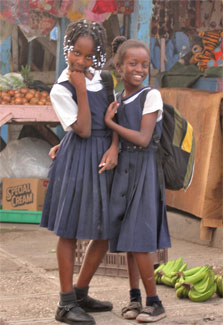Study finds mothers can help reduce daughters' risk of HIV infection in Jamaica
January / February 2015 | Volume 14, Issue 1

Photo by Kathy Strauss,
courtesy of Photoshare
Mothers can play a critical role in protecting
their daughters from HIV, according to a
study supported by the National Institute of
Nursing Research.
by Cathy Kristiansen
Adolescent girls in Jamaica have more than twice the risk of contracting HIV than other groups, based on a range of social, cultural and economic influences. Studies in the U.S. have shown that enlisting mothers of at-risk girls can reduce their chances of HIV infection. Scientists supported by the
National Institute of Nursing Research (NINR) adapted the approach to see if the same is true in Jamaica.
"We can't just assume that U.S. findings translate into other countries," said Dr. Katherine Hutchinson, of Boston College Connell School of Nursing, who led the Jamaica research. "We need to develop interventions that can be effective in the contexts in which people live." About 1.8 percent of Jamaicans aged 15-49 are HIV-positive, or about 30,000 people, according to UNAIDS.
Several factors contribute to the lack of awareness and empowerment in Jamaican adolescent girls for avoiding HIV risk, Hutchinson said. Sex education is limited in schools. Churches and parents typically promote abstinence, especially for girls, so do not inform students about safe sex. Hutchinson also noted that gender norms fuel the risk, since young men are encouraged to gain sexual experience and often choose girls who can be more easily seduced.
In the study, U.S. and Jamaican scientists enrolled 330 mother-daughter pairs to test their strategy for reducing HIV. A control group received general health information while the study group participated in a two-day session focused on teaching them about HIV risk, the importance of condom use, strategies girls could use to refuse sex or insist on a condom, and how to recognize and avoid situations where coercion could arise. The participants watched videos with Jamaican music and dance moves, role-played and discussed topics such as how to open conversations about sex and communicate well. In one sketch, a mother took her daughter to buy condoms, which in Jamaica involves asking a pharmacist who might balk at supplying a teen girl.
"We found evidence that the whole mother-daughter approach could be effective at changing some of the known mediators of risk," Hutchinson said. Mother-daughter communication and the mothers' monitoring increased during the trial and remained higher three and six months later.
Helping the mothers develop tools to take action was key, Hutchinson noted. "A lot of mothers haven't had ideal role models in their own lives and don't have the knowledge and skills to speak with their daughters about sex. But if you can help people with opening lines for discussion, with strategies on how to talk to their daughters and how to monitor their behavior, that is powerful."
The study also revealed that the mothers' own sexual role-modeling can be a critical influence on their daughters' actions, she added. "How do their mothers behave around men? Do they let themselves get pushed around? Do they bring lots of different men home? The mothers' own behaviors may be influential, even if they are telling their daughters to abstain,” Hutchinson said.
Aside from testing the intervention, another key aim of the study was to build research capacity in Jamaica. The team included more than eight nursing and medical faculty members at the University of the West Indies, who gained research skills and contributed to scientific papers. Nursing students and practicing nurses were also trained during the study, for instance in data collection and working with enrollees.
At the end of the trial, the team sent the materials to community-based family organizations so they could continue using the videos, handouts, games and materials to educate adolescent girls and mothers about HIV prevention. Hutchinson hopes government policymaker interest in the intervention - in Jamaica and other similar settings - will grow and lead to adoption of the program.
More Information
To view Adobe PDF files,
download current, free accessible plug-ins from Adobe's website.